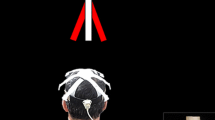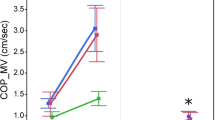Abstract
Purpose
This study aims at verifying if impaired sensorimotor control observed in adolescents and young adults with scoliosis is also present in adult patients who underwent surgery to reduce their spine deformation.
Methods
The study included ten healthy adults and ten adults with idiopathic scoliosis who underwent surgery to reduce their spine deformation. Galvanic vestibular stimulation was delivered to assess sensorimotor control. Vertical forces under each foot and horizontal displacement of the upper body were measured before, during and after stimulation. Balance control was assessed by calculating the root mean square values of kinematic and kinetic variables.
Results
The amplitude of the vestibular-evoked postural response was 3.4 % (0.8–6.0 %) and 4.5 % (−0.4 to 9.5 %) of the maximal range of motion. Therefore, spine surgery did not limit the postural response. Patients with idiopathic scoliosis exhibited larger body sway than the healthy controls during and immediately after vestibular stimulation. The maximal normalized lateral displacement of the body was 0.85 and 0.40 cm/m and maximal normalized vertical force was 0.78 vs. 0.39 N/kg, for idiopathic scoliosis and healthy groups, respectively.
Conclusions
This result suggests that dysfunctional sensorimotor integration is still present even in adult idiopathic scoliosis that underwent spine deformation correction.



Similar content being viewed by others
References
Ueno M, Takaso M, Nakazawa T, Imura T, Saito W, Shintani R, Uchida K, Fukuda M, Takahashi K, Ohtori S, Kotani T, Minami S (2011) A 5-year epidemiological study on the prevalence rate of idiopathic scoliosis in Tokyo: school screening of more than 250,000 children. J Orthop Sci 16:1–6. doi:10.1007/s00776-010-0009-z
Soucacos PN, Zacharis K, Gelalis J, Soultanis K, Kalos N, Beris A, Xenakis T, Johnson EO (1998) Assessment of curve progression in idiopathic scoliosis. Eur Spine J 7:270–277
Miller NH, Schwab DL, Sponseller PD, Manolio TA, Pugh EW, Wilson AP (2001) Characterization of idiopathic scoliosis in a clinically well-defined population. Clin Orthop Relat Res 392:349–357
Manzoni D, Miele F (2002) Vestibular mechanisms involved in idiopathic scoliosis. Arch Ital Biol 140:67–80
Wang WJ, Yeung HY, Chu WC, Tang NL, Lee KM, Qiu Y, Burwell RG, Cheng JC (2011) Top theories for the etiopathogenesis of adolescent idiopathic scoliosis. J Pediatr Orthop 31:S14–S27. doi:10.1097/BPO.0b013e3181f73c12
Simoneau M, Lamothe V, Hutin E, Mercier P, Teasdale N, Blouin J (2009) Evidence for cognitive vestibular integration impairment in idiopathic scoliosis patients. BMC Neurosci 10:102. doi:10.1186/1471-2202-10-102
Lambert FM, Malinvaud D, Glaunes J, Bergot C, Straka H, Vidal PP (2009) Vestibular asymmetry as the cause of idiopathic scoliosis: a possible answer from Xenopus. J Neurosci 29:12477–12483. doi:10.1523/JNEUROSCI.2583-09.2009
Wiener-Vacher SR, Mazda K (1998) Asymmetric otolith vestibulo-ocular responses in children with idiopathic scoliosis. J Pediatr 132:1028–1032 (pii S0022-3476(98)70403-2)
Pincott JR, Davies JS, Taffs LF (1984) Scoliosis caused by section of dorsal spinal nerve roots. J Bone Joint Surg Br 66:27–29
Pialasse JP, Descarreaux M, Mercier P, Blouin J, Simoneau M (2012) Sensorimotor integration in adolescent idiopathic scoliosis patients. In: Recent advances in scoliosis. InTech, 47–70
Domenech J, Garcia-Marti G, Marti-Bonmati L, Barrios C, Tormos JM, Pascual-Leone A (2011) Abnormal activation of the motor cortical network in idiopathic scoliosis demonstrated by functional MRI. Eur Spine J 20:1069–1078. doi:10.1007/s00586-011-1776-8
Simoneau M, Richer N, Mercier P, Allard P, Teasdale N (2006) Sensory deprivation and balance control in idiopathic scoliosis adolescent. Exp Brain Res 170:576–582. doi:10.1007/s00221-005-0246-0
Simoneau M, Mercier P, Blouin J, Allard P, Teasdale N (2006) Altered sensory-weighting mechanisms is observed in adolescents with idiopathic scoliosis. BMC Neurosci 7:68. doi:10.1186/1471-2202-7-68
Pialasse JP, Laurendeau S, Descarreaux M, Blouin J, Simoneau M (2013) Is abnormal vestibulomotor responses related to idiopathic scoliosis onset or severity? Med Hypotheses 80:234–236. doi:10.1016/j.mehy.2012.11.035
Haumont T, Gauchard GC, Lascombes P, Perrin PP (2011) Postural instability in early-stage idiopathic scoliosis in adolescent girls. Spine 36:E847–E854. doi:10.1097/BRS.0b013e3181ff5837
Day BL, Cole J (2002) Vestibular-evoked postural responses in the absence of somatosensory information. Brain 125:2081–2088
Osborne JW (2012) Best practices in data cleaning: a complete guide to everything you need to do before and after collecting your data. SAGE Publications, New Delhi
Mall V, Linder M, Herpers M, Schelle A, Mendez-Mendez J, Korinthenberg R, Schumacher M, Spreer J (2005) Recruitment of the sensorimotor cortex—a developmental FMRI study. Neuropediatrics 36:373–379. doi:10.1055/s-2005-873077
Byl NN, Holland S, Jurek A, Hu SS (1997) Postural imbalance and vibratory sensitivity in patients with idiopathic scoliosis: implications for treatment. J Orthop Sports Phys Ther 26:60–68
Peterka RJ (2002) Sensorimotor integration in human postural control. J Neurophysiol 88:1097–1118
Ernst MO, Banks MS (2002) Humans integrate visual and haptic information in a statistically optimal fashion. Nature 415:429–433. doi:10.1038/415429a
Shi L, Wang D, Chu WC, Burwell GR, Wong TT, Heng PA, Cheng JC (2011) Automatic MRI segmentation and morphoanatomy analysis of the vestibular system in adolescent idiopathic scoliosis. Neuroimage 54(Suppl 1):S180–S188. doi:10.1016/j.neuroimage.2010.04.002
Lambert FM, Malinvaud D, Gratacap M, Straka H, Vidal PP (2013) Restricted neural plasticity in vestibulospinal pathways after unilateral labyrinthectomy as the origin for scoliotic deformations. J Neurosci 33:6845–6856. doi:10.1523/JNEUROSCI.4842-12.2013
Joly O, Rousie D, Jissendi P, Rousie M, Franko E (2014) A new approach to corpus callosum anomalies in idiopathic scoliosis using diffusion tensor magnetic resonance imaging. Eur Spine J 23:2643–2649. doi:10.1007/s00586-014-3435-3
Domenech J, Barrios C, Tormos JM, Pascual-Leone A (2013) Somatosensory cortectomy induces motor cortical hyperexcitability and scoliosis: an experimental study in developing rats. Spine J 13:938–946. doi:10.1016/j.spinee.2013.03.002
Acknowledgments
The authors thank La Fondation Yves Cotrel—Institut de France for funding this study. JPP was supported by the Fondation Chiropratique du Québec and the Ordre des chiropraticiens du Québec, which co-funded a scholarship with the Fonds de Recherche du Québec en Santé. JPP also received support from the European Chiropractic Union.
Author information
Authors and Affiliations
Corresponding author
Ethics declarations
Conflict of interest
None of the authors has any potential conflict of interest.
Rights and permissions
About this article
Cite this article
Pialasse, JP., Mercier, P., Descarreaux, M. et al. Assessment of sensorimotor control in adults with surgical correction for idiopathic scoliosis. Eur Spine J 25, 3347–3352 (2016). https://doi.org/10.1007/s00586-016-4421-8
Received:
Revised:
Accepted:
Published:
Issue Date:
DOI: https://doi.org/10.1007/s00586-016-4421-8




